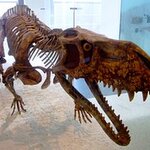Paleontology

The Paleontologist community in China and around the world are all aflutter over a recent find in the Erlian Basin of Inner Mongolia. Known more for its heavy oil potential and favorite export - pollution, northeastern China is the preferred stomping ground for the savvy petroleum geologist.
As a complete aside, it also boasts the prettiest portion of the gene pool, or so says one of my stomping friends having explored much of Asia. So, home to pretty women today and, as it would seem, an enormous bird-like dinosaur some 70 million years ago. Fancy that.
Only a youngster when he passed…
Following up their 2000 discovery of an ancient reptile commonly referred to as SuperCroc, paleontologists from the University of Chicago and McGill University today unveiled key fossils of five previously unknown or poorly understood crocodile species. Most of them walked "upright" with their arms and legs under the body like land mammals, with their bellies touching the ground. The discoveries are reported in the latest issue of ZooKeys.
The five new species, dubbed BoarCroc, RatCroc, DuckCroc, DogCroc and PancakeCroc by University of Chicago Paleontologist Paul Sereno, lived…
The siltstones, sandstones, mudstones and conglomerates of the Chuckanut Formation were laid down about 40-54 million years ago during the Eocene epoch, a time of luxuriant plant growth in the subtropical flood plain that covered much of the Pacific Northwest.

Over vast expanses of time, powerful tectonic forces have massaged the western edge of the continent, smashing together a seemingly endless number of islands to produce what we now know as North America and the Pacific Northwest. Intuition tells us that the earth’s crust is a permanent, fixed outer shell – terra firma. Aside from the rare event of an earthquake or the eruption of Mount St. Helen’s, our world seems unchanging, the landscape constant. In fact, it has been on the move for billions of years and continues to shift each day.
As the earth’s core began cooling, some 4.5 billion…

Co-ordination of flight requires tremendous brainpower, and co-ordination of active flight, with the constant shift in the shape and location of massive wings, even more so. Nature is extremely parsimonious, not frittering away investment in any organ where it is not needed.
Given the engineering challenges and the energy costs of getting each additional gram of weight off the ground, pterosaurs would never have developed such large and heavy “on board computers” unless they clearly paid their own way in faster, more nimble flight that would have allowed their owners to catch more prey and…

A new species of dinosaur, an ankylosaur, that lived 112 million years ago during the early Cretaceous of central Montana has been described by paleontologists writing in the Canadian Journal of Earth Sciences and the Bulletin of the Buffalo Society of Natural Sciences.
Ankylosaurs are the biological version of an army tank; they were protected by a plate-like armor with two sets of sharp spikes on each side of the head, and a skull so thick that even 'raptors' such as Deinonychus could leave barely more than a scratch.
Bill and Kris Parsons, Research associates of the Buffalo…
A Tale Of Two Cities (by Charles Dickens) was a weekly serial publication at this time 150 years ago. My tale of two feathers is about dinosaurs and modern birds with a twist on feathers.
Welcome a new name, Darwinopterus -- a flying dinosaur -- Darwin's wing. Found in rocks from the Middle Jurassic of China earlier this year, the 20 plus skeletons are about 160 million years old. The newly defined pterosaur (Mesozoic flying reptile) "provides the first insights into a transition between basal, predominantly long-tailed pterosaurs and the…
Had you been swimming with the marine fossils that were laid down in the Eocene Epoch in Oregon, some 55 to 38 million years ago, you'd be treading water right up to where the Cascade Mountains are today.
The Farallon Plate took a turn north some 57 million years ago, sweeping much of western coastal Oregon along with it. The Cascades were beginning to uplift and were fast becoming the breakwater for a retreating Pacific Ocean.
By the middle Oligocene, the Cascadia Subduction Zone was in full force with growing pressure erupting volcanoes along the Western Cascades, a…
For several years, a European amateur science group was on the trail of dinosaur prints and last spring they made a significant discovery. Now authenticated by scientists at Lyon University and France's National Center for Scientific Research, the find is one of the largest and most well preserved prints from a sauropod estimated to be 150 million years old.
What's particularly exciting about this finding--in addition to the pure excitement from being able to directly witness the movements of our planet's once great giants--is that the possibility of important scientific progress coming from…

Dinosaurs, long hailed as the rulers of the Triassic almost lost the title belt to a group of crocodilian upstarts, the crurotarsans. In a short lived battle for survival, geologically speaking, the two groups ran head-to-head for about thirty million years.
The Crurotarsi or "cross-ankles" as they are affectionately known, are a group of archosaurs - formerly known as Pseudosuchians when paleontologist Paul Serono, the darling of National Geographic, renamed them for their node-based clade in 1991.